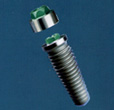
| |
||||
Replace® Select Implants |
 |
|||
|
Abstracts New An Auger Spectroscopic Analysis of Dental Implant Surface Contamination Finite Element Analysis to Determine Implant Preload-New Lang LA, Kang B, Wang R-F,and Lang BR. Finite element analysis to determine implant preload. J Prosthet Dent 2003;90:539-545. Abstract:
The nature of the forces used to clamp implant components together
is still a mystery. How the forces are generated and sustained is
lacking in the literature. This study examined the dynamic nature
of developing the preload in an implant complex using finite element
analysis (FEA). The implant complex was modeled three-dimensionally
in accordance with the geometric designs for the Nobel Biocare implant
systems. A thread helix design for the abutment screw and implant
screw bore was modeled in order to create the exact geometric design
for these units in the implant systems. Modeling the threads to
the exact machining specifications permitted simulation of screw
tightening using specific finite element software. Using these models,
the effect of the coefficient of friction on the development of
preload amount in the implant complex during and after abutment
screw tightening was determined. Using the software programs HyperWorks
and LS3D-Dyna, two 3-dimensional finite element models of (1) a
Brånemark System 3.75 X 10 mm titaniium Mark III implant,
a CeraOne titanum abutment, a Unigrip gold alloy abutment screw,
and (2) a Replace Select System 4.30 X 10 mm titanium implant, a
Straight Esthetic titanium abutment, and a TorqTite titanium abutment
screw were created. The abutment screws were subjected to a tightening
torque in increments of 1 Ncm from 0-64 Ncm using ABAQUS software.
In the first experiment, the coefficient of friction was set to
0.20 between the titanium bearing surface of the abutments and the
implant bearing surfaces, and 0.26 between the gold abutment screw
and the titanium implant screw bore. In the second experiment, the
coefficient of friction was varied; the titanium implant and titanium
abutment bearing surfaces were set to a coefficient of friction
of 0.20 while the Mark III gold and the Replace Select titanium
abutment screws and their respective titanium screw bores in the
implants were set to 0.12. The preload amount in Newton’s was
determined from the finite element analysis. The stress distribution
pattern clearly demonstrated a transfer of preload force from the
screw to the implant during tightening. A preload of 75% of the
yield strength of the abutment screw was not established using the
recommended tightening torques. An Auger Spectroscopic Analysis of Dental Implant Surface Contamination Investigators: K Stathis, BR Lang, ME Razzoog, and WC Wagner. Abstract:
A key factor in osseointegration of titanium implants has been attributed
to the presence of surface contamination in the “as delivered
state.” The purpose of this study was to examine the surface
of implants from six major implant systems and to assess the presence,
type and amount of surface contaminants following manufacturing.
Five implant obtained from different manufacturing lots for the
following systems formed the experimental population: 1) 3I, 2)
Impla-Med, 3) Brånemark, 4) Steri-Oss, 5) Lifecore –
Restore, and 6) Swede-Vent. Four sites 5 x 5 microns in area were
surveyed from the flat bottom on each implant using Auger electron
spectroscopy (AES). The elements present in the Auger spectra for
each implant system were identified and the surface area of the
contaminants measured. Contaminating elements included carbon, calcium,
sulfur, phosphorus, silicon, boron, chloride, potassium, fluorine,
silver, cobalt, aluminum, antimony, vanadium, nickel and iron. The
Brånemark and Steri-Oss implants exhibited the highest average
surface concentrations of titanium (31.7 and 32% respectively),
and oxygen (31.2 and 34.9% respectively). These implant systems
also demonstrated the lowest amounts of total contaminants (16.7
and 16.2%). The Lifecore – Restore implants had the highest
amount of total contaminants (29.6%) and the lowest average concentration
of titanium (16.8% and oxygen (22.7%). Swede-Vent implants had high
amounts of surface fluorine (7.1%), while the Steri-Oss implants
had high amounts of silicon (5.6%). |
||||
|
New
Projects | Origin of the Center
| Implants | Procera
| References Copyright
© 2001 |
||||
